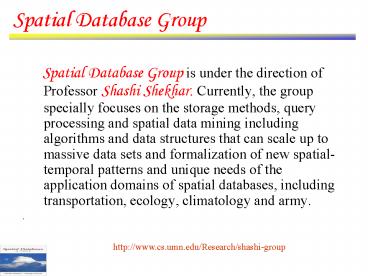Spatial Database Group PowerPoint PPT Presentation
1 / 15
Title: Spatial Database Group
1
Spatial Database Group
- Spatial Database Group is under the
direction of Professor Shashi Shekhar. Currently,
the group specially focuses on the storage
methods, query processing and spatial data mining
including algorithms and data structures that can
scale up to massive data sets and formalization
of new spatial- temporal patterns and unique
needs of the application domains of spatial
databases, including transportation, ecology,
climatology and army. - .
http//www.cs.umn.edu/Research/shashi-group
2
Efficient Query Processing Techniques in Spatial
Time Series Data Pusheng Zhang
Motivation
- Spatial Time Series Data
- A collection of time series, each referring a
spatial location - e.g., sea surface temperature data in Pacific in
1950-2000 - Correlation-based Similarity Queries range
query, nearest-neighbor query, join query - E.g., finding effected land regions in US by El
Nino Index(a time series) - Queries are Computationally Expensive!
- Large spatial location and long time series (ts)
- E.g., data with 1M and 2M locations with ts600,
correlation 1M 2M 2T times - Applications
- Data Mining in NASA Earth Science Data
- Tele-connection Finding
- e,.g., El Nino effects
- Anomalous warming in Pacific
- Heavy rainfall in Peru
- Warming in Minnesota
3
Efficient Query Processing Techniques in Spatial
Time Series Data Pusheng Zhang
Problem Statement
Proposed Approach
- Given
- A spatial time series and
- A set of operations e.g., range query, join,
insert, delete, bulk-load - Find
- A disk-based data structure
- Objective
- Efficiency minimizing computational costs
- Constrains
- Completeness no false dismissals for operations
- Correctness no false admissions for operations
- Spatial Cone tree
- Normalized time series is located on the surface
of hypersphere - Cone containing multiple normalized time series
in hypersphere - Grouping similar time series together based on
spatial proximity - Query processing on cone-level
4
Efficient Query Processing Techniques in Spatial
Time Series Data Pusheng Zhang
Performance Evaluation
References
- Workload
- NASA Earth science data
- Monthly USA Net Primary Product data at 0.5
degree by 0.5 degree resolution in 1982-93 - Monthly Eastern Pacific Sea Surface Temp data at
0.5 degree at 0.5 degree resolution in 1982-93 - Experimental results
- Range Queries
- save 46-89
- Join Queries
- save 40-98
1 Pusheng Zhang, Yan Huang, Shashi Shekhar,
Exploiting Spatial Autocorrelation to
Efficiently Process Correlation-Based Similarity
Queries, Intl Symposium on Spatial and Temporal
Databases, 2003 2 Pusheng Zhang, Yan Huang,
Shashi Shekhar, Correlation Analysis of Spatial
Time Series Datasets A Filter-and-Refine
Approach, Pacific-Asia Conf. on Data Mining and
Knowledge Discovery, 2003 3 Pusheng Zhang,
Shashi Shekhar, Vipin Kumar, Yan Huang, Spatial
Cone Tree An Index Structure for
Correlation-based Similarity Queries on Spatial
Time Series, Intl Workshop on Next Generation
Geospatial Information
5
- Processing In-Route Nearest Neighbor Queries
- Shashi Shekhar and Jin Soung Yoo
Applications
- Location-based Services
- Advanced Traveler Information Systems
Nearest Neighbor Queries
- Scenario A wireless subscriber is in an
unfamiliar city and needs to find the nearest gas
station. - Nearest Neighbor (NN) is different depending on
its criteria.
- Euclidean based NN is f4.
- Road-distance based NN is f3.
- NN on the way to destination is f5.
- NN least branched off to predetermined route on
the way to destination is f6. - NN through with smallest travel distance to
destination from current location is f7. - Continuous NN to the route is a set of
ltf3,p1,p2gt,ltf4,p2,p3gt,ltf5,p3,p4gt, etc.
6
- Processing In-Route Nearest Neighbor Queries
- Shashi Shekhar and Jin Soung Yoo
In-Route Nearest Neighbor Query
- Find a facility instance via which the detour
from the original route on the way to the
destination is smallest
- Figure2. Recursive spatial range query-based
method
A Comparison of Alternative Approaches
- Simple Graph-based Method(SGB)
- Recursive Spatial Range Query-based Method(RSR)
- Spatial Distance Join-based Method(SDJ)
- Precomputed Zone-based Method(PCZ)
- Figure 3. Spatial distance join-based method
7
- Processing In-Route Nearest Neighbor Queries
- Shashi Shekhar and Jin Soung Yoo
Experiment Results
- How does road map size affect the response time
and the storage needs of all methods? - What is the effect of facility density on the
performance of all methods? - What is the effect of route length on the
performance of all methods?
8
Evacuation Planning A Capacity Constrained
Routing Approach Qingsong Lu
Motivation
- Homeland Security Respond to Bio-Chem Attack
Attack Location On Base Map
Weather Data
Plume Simulation
Demographics Info.
Transportation Networks
- Natural Disaster Preparation Hurricane
Evacuation
Traffic congestion caused by Hurricane Andrew,
1992
( North Carolina)
Evacuation Route Signs
( Florida)
9
Example Network and Evacuation Routes
N1, 50 (10)
Node
(7,1)
Node ID, Max Capacity (Initial Occupancy)
(3,3)
N3, 30
N5, 6
N4, 8
(3,3)
Edge
(7,1)
(3,4)
(5,4)
(Max Capacity, Travel time)
N2, 50 (5)
N6, 10
N7, 8
Exit
Node ID
N9, 25
(3,5)
(5,5)
(6,4)
(14,4)
(6,4)
(8,1)
EXIT 1
N11, 8
(3,3)
N10, 30
(6,3)
N8, 65 (15)
N13
Each
shows the route of one group of people in
evacuation.
(3,1)
(6,4)
N12, 18
(3,3)
N14
EXIT 2
10
Example Network Evacuation Flow Chart
Exits
Node
Time
Source Nodes N1 N2 N8
Exit Nodes N13, N14
of people move from each source
1
1
1
11
Real Scenario Minnesota Nuclear Power Plant
(Monticello) Emergency
Evacuation Route Planning
(a) Old plan uses orange routes, e.g. State
Highway 95, going far away from destination,
increase total evacuation time.
(b) Old plan puts high load on highways I-94 and
US-10. Our plan uses more roads to reduce
congestion.
Source cities
Evacuation Destination
Monticello Power Plant
Routes used only by old plan
Routes used only by result plan of capacity
constrained routing
Routes used by both plans
(c) Congestion is likely in old plan near
evacuation destination due to capacity
constraints. Our plan has richer routes near
destination to reduce congestion and total
evacuation time.
Twin Cities
12
Spatial
13
Data
14
Base
15
- Group

